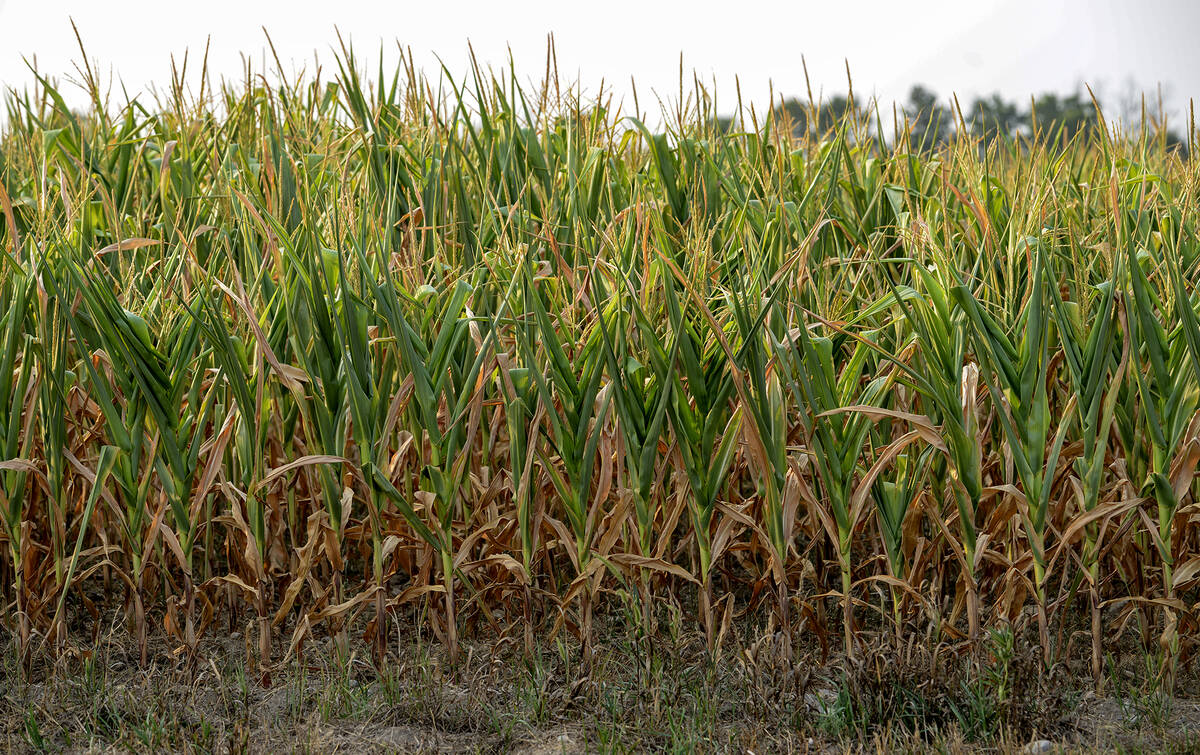Ontario soybean prices have risen $1 per bushel over the past month. The domestic market is being pulled higher by the energy complex and stronger meal values. Soybean exports are lagging last year’s pace. The fundamentals are somewhat bearish unless South America has adverse weather conditions.
Ontario corn prices are up 20 cents per bu. since mid-December. Stronger energy prices are the main factor supporting the corn market due to the ethanol component. Ontario soft red winter wheat prices are down 50 to 60 cents per bu. from last month. Offshore wheat movement has slowed. Canadian and U.S. flour millers have their requirements covered until new crop.
Quick look
Soybeans: World values are under pressure from aggressive offers from Brazil. Although domestic demand is stronger than last year, export demand is lagging.
Corn: High ethanol margins, seasonally high feed inventories and increased export demand are keeping corn prices high.
Wheat: The market is in a seasonal low and producers are advised to be 50 per cent sold on their 2021 production, increasing to 60 per cent when the market rallies in late winter.
Read Also

Extreme variability marks Ontario’s 2025 corn crop
The yield potential of Ontario’s 2025 corn crop was lost in some areas due to extreme dry conditions.
World corn has held value due to uncertainty in South American production. At the time of writing this article, drier conditions were noted in Paraguay, Uruguay, Argentina and Brazil’s southern state of Rio Grande Do Sul. The 30-day forecast calls for average to above average temperatures and below normal precipitation.
The Brazilian soybean harvest will move into high gear over the next month. A record crop is expected. We may see downward revisions to Argentinean soybean production but this will have minimal influence on the market.
World wheat values are under pressure with the year-over-year increase in Argentinean and Australian production. Seasonally, the wheat market grinds lower in January and February. The wheat complex tends to incorporate a risk premium when the Northern Hemisphere crop comes out of dormancy. The U.S. Southern Plains, Ukraine and Russia have experienced drier conditions over the winter so timely rains are needed in March and April.
Canada and the U.S. are contending with historically high inflation levels. The Fed Fund Futures are factoring three interest rate adjustments from the U.S. Federal Reserve in 2022. Analysts are looking for three to four increases of 25 basis points each.
The Bank of Canada is expected to increase its benchmark rate from 0.25 per cent to 1.5 per cent by the end of the calendar year. U.S. crude oil inventories have dropped to lower levels, which will be supportive to the Canadian dollar and all commodity markets during the first quarter of 2022.
Soybeans
Ontario farmers have slowed soybean sales over the past month, causing commercial stocks to decline. The Canadian domestic soybean crush for the week ending Jan. 2 was 915,800 tonnes, up nearly 100,000 tonnes from last year. Stronger meal and oil values have enhanced the crush margin structure resulting in the higher crush pace.
While domestic usage is above year-ago levels, exports are lagging. Canadian crop year-to-date exports for the week ending Jan. 2 were 2.4 million tonnes, down nearly 500,000 tonnes from the 2020/21 crop year.
Soybean oil prices have received spillover strength from the world vegetable oil market. Palm oil futures have been trading near contract highs due to flooding in Malaysia and Indonesia. The total damage is still unknown and we expect to see a sharp year-over-year decline in palm oil production during December and January.
Soymeal futures made fresh highs in early January. Cash values are at the highest levels since May 2021. U.S. soymeal export commitments are running five per cent above last year. The world meal market is firm and will likely hold value until Argentina’s harvest moves into full swing next month.
U.S. soybean export sales commitments are down 24 per cent from year-ago levels. Brazil is dominating the export market. Offers out of Paranagua are discount to the U.S. Gulf and Canadian St Lawrence.
China has been actively buying Brazilian soybeans while shying away from old crop Canadian and U.S. origin. We may see the USDA trim Argentinian and Brazilian production on upcoming USDA WASDE (World Agriculture Supply and Demand Estimate) reports but this won’t change the market structure in the short term. The soybean crop in Brazil is basically made at this time.
Ontario farmer selling has slowed. Domestic soybean demand is stronger than last year while exports are lagging. World values are under pressure due to aggressive offers from Brazil.
What to do: We’ve advised farmers to be 70 per cent sold on their 2021 production. This week, we’re advising farmers to move to 80 per cent sold. We’ll save the final 20 per cent as reserve in case adverse conditions develop in North America this spring.
Corn
At the time of writing this article, Ontario elevator corn bids were in the range of $7.40-$7.50 per bu. We haven’t seen these types of prices since August 2021. Bids from ethanol processors were at a 20 to 30 cent per bu. premium.
The corn market is firm for three main reasons. Profitable ethanol margins have been driving the domestic grind. U.S. crude oil stocks have dropped to historical low levels and this will keep energy prices at the higher levels moving through the main winter period.
Secondly, cattle on feed inventories are at seasonal highs. Finally, Canadian corn exports for the week ending Jan. 2 were 511,900 tonnes, up 80,000 tonnes from last year. Stronger wheat prices in Europe have enhanced demand for Ontario corn from Ireland and Portugal.
The U.S. corn market is contending with the same factors as Canada. U.S. corn exports are coming in larger than expected albeit down marginally from year-ago levels. U.S. corn for ethanol usage will likely finish above the USDA estimate.
On the December WASDE, the 2021/22 U.S. corn carryout was estimated at 38 million tonnes. However, we believe we could see the ending stocks eventually drop to 34 million tonnes. This compares to a five-year average carryout of 52 million tonnes. The corn market will remain firm given the tighter stocks situation.
The Argentinean crop will move through the major pollination stage during January and February. Above normal temperatures and below normal rainfall will trim production estimates.
For Brazil, the first crop corn is only 26-27 million tonnes and will be harvested over the next month. The exportable surplus comes from Brazil’s second corn crop, which is expected to reach 91 million tonnes. This second crop will only be planted in late January and early February. The harvest will occur in June.
Argentinean corn will offer some competition on exports starting in March. However, U.S. and Canadian corn export sales will come to a standstill in May.
What to do: We’ve advised Ontario farmers to be 60 per cent sold on their 2021 production. This week, we’re advising farmers to move to 70 per cent sold. The corn market tends to incorporate a risk premium during the North American spring planting period. Last year, the highest prices were in late April or early May, just before the main Brazilian harvest. Our next sale will likely occur in April.
Wheat
The wheat market has strong seasonal tendencies. Farmers in the U.S, Russia and Ukraine sell approximately 40 to 50 per cent of the crop during the summer. Wheat prices tend to make annual lows during July.
After the Northern Hemisphere harvest is finished, the market experiences a rally from September through November. Major importers cover their demand at this time.
The wheat market is deathly quiet in December and January. Australia and Argentina move through the harvest period and saturate demand in Southeast Asia and South America. The next rally in the wheat market occurs in late February and March when the Northern Hemisphere winter wheat comes out of dormancy.
Kansas receives seasonal rains during April. The wheat complex has a hard time rallying in April unless Kansas is particularly dry. This is the way it has been for the last 100 years. This is way it will be for the next 100 years.
Given the strong seasonal tendency, we look for factors that could alter the seasonal trend. Australia has harvested a record crop and Argentinean output was marginally higher than last year. The U.S. Southern Plains are on the drier side but conditions over the winter have little correlation with actual yields. Kansas yields are largely determined in April.
The Black Sea region has received timely precipitation over the past couple weeks. At this stage, there are no production concerns with Ukraine or Russia. France and Germany are also in good shape with no extreme weather. There are no factors that will alter the seasonal price pattern.
What to do: We’ve advised producers to be 50 per cent sold on their 2021 production. This week, we’re advising producers to increase sales to 60 per cent. Our strategy is to sell the next 20 per cent during the seasonal rally in late winter. We’ll have 20 per cent of the stocks left in case there is a major drought in one of the main Northern Hemisphere production regions.













